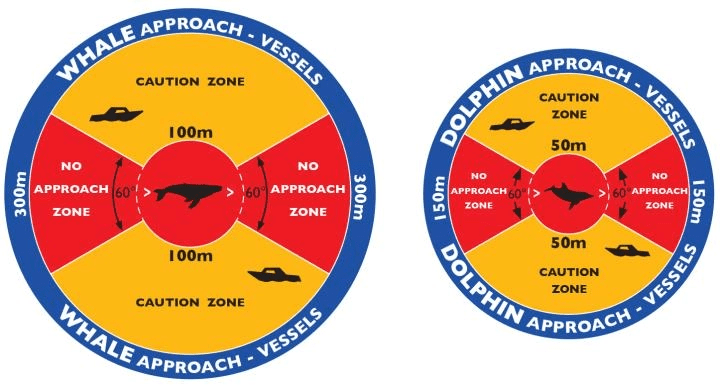Whale Watch Guide & Information
Port Stephens enjoys a fantastic whale watching season from May to November every year. This means we have between 20,000 to 30,000 whales pass by Port Stephens every year.
Getting to Know Whales
Whales belong to a group of marine animals known as cetaceans. There are 85 known species of cetaceans in the world and they are broken up into 2 groups:
Baleen Whales (Mysticetes)
There are 13 known species of baleen whales, including the humpback and southern right whale both of which you are likely to cross paths with in Port Stephens from May-Nov. Instead of teeth they have rows of fibrous bristle-like baleen plates which they use to strain mouthfuls of water for fish, plankton & krill.
Toothed Whales (Odontocetes)
There are 72 known species of toothed whales and like their name suggests, they have teeth as oppose to baleen plates. Toothed whales feed on squid, fish, and sometimes marine mammals.
Difference between toothed and baleen
The other distinctive difference between the appearance of toothed and baleen whales, is the blowhole.
Whales have lungs and breathe air, but are unable to breathe through their mouths, so they breathe through their blowhole.
Located on top of the whales head, the blowhole opens briefly when the animal is at the surface and is kept closed when the whale dives. The exact location and shape varies between whale species, however toothed whales have only one blowhole, whilst baleen whales have two.
All whale species have streamlined, smooth-surfaced bodies, no external ears, flippers like forelimbs for steering and maneuvering, very few hairs, and a layer of insulating blubber. These characteristics make them ideally suited to their marine environment.
Whale Watching in Port Stephens
Port Stephens enjoys a fantastic whale watching season from May to November every year. This means we have between 20,000 to 30,000 whales pass by Port Stephens every year.
On a Moonshadow – TQC whale watch cruise you may come across one or more of the following types of whales
- Humpback
- Melon Headed
- Brydes
- Southern Right
- Pilot
- False Killer
- Orca Whale
But mostly it is the Humpback whale that we are lucky enough to meet in Port Stephens.
Whale Watching Rules
Whales are protected species so there are some rules that must be adhered to when watching whales.
- No more than three boats at the one time
- Do not disturb or harass the whales
- Do not approach any closer than 100 metres (300 metres for a calf)
- Do not feed or touch
- Keep noise to a minimum
- Do not approach from behind or head-on
Humpback Whales
Approximately 30,000 of the world’s humpback whale population pass the Port Stephens coast line on their 12,000km migration every year.
The Humpback Whale undertakes a northern migration from May to August. It travels from its feeding grounds in Antarctica to the warmer tropical waters of the Pacific.
They then make the return journey south from August to November. This is the longest documented migration of any mammal on earth and the reason for the journey is to breed.
Despite its enormous size at birth, a newborn whale (calf) is born without a protective blubber layer. So if it were born in the near-freezing temperatures of the Antarctic waters, its chances of survival would be slim. So the whales head north to the warmer climate to give birth to their young.
Humpback Facts
- Length: Adults – 14m to 18m
- Calves – 4m to 5m at birth
- Weight: Adults – up to 50 tonnes
- Calves – 2 tonnes at birth
- Cruising speed: 7km/hr
- Protected since 1965
- Individual humpbacks can be identified by markings under their tail
- The spread of its jaw is over 4 metres
- Sings the longest, most complex songs in the animal kingdom
- Humpbacks have the most diverse feeding techniques of all Baleen Whales – they scream when hunting fish to scare and confuse them
- You can distinguish the humpback whale from other whale species by its small dorsal fin that you see sticking out of the water when the whale arches its back to dive and this is how the humpback got its name.
Whale Tricks
The humpback whale is a favourite with whale watchers in Port Stephens due to its spectacular display of acrobatic tricks.
We often see them breach. This is when the whale leaps right out of the water, rolls in the air with its huge fins outstretched like wings and then crashes back into the water.
Here are some more whale tricks you may be lucky enough to see.
- Tail slap – when the whale’s tail comes right out of the water and slaps the surface
- Pectoral slap – when the pectoral fin comes right out of the water and makes a big slapping noise as it breaks the surface
- Spy hop – the whale’s head bobs up out of the water
- Body roll – this is a full 360 degree spin where you get a glimpse of the whale’s underbelly

